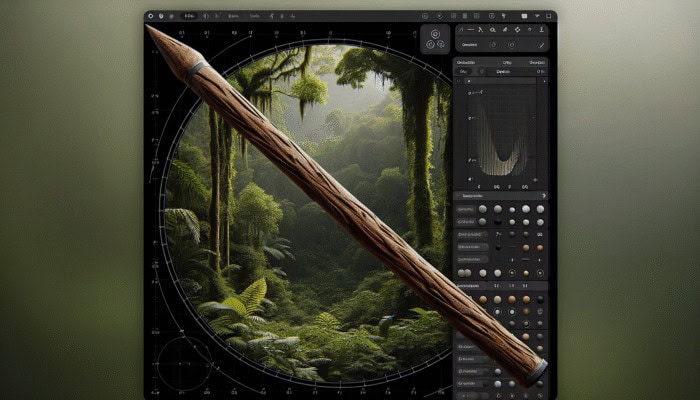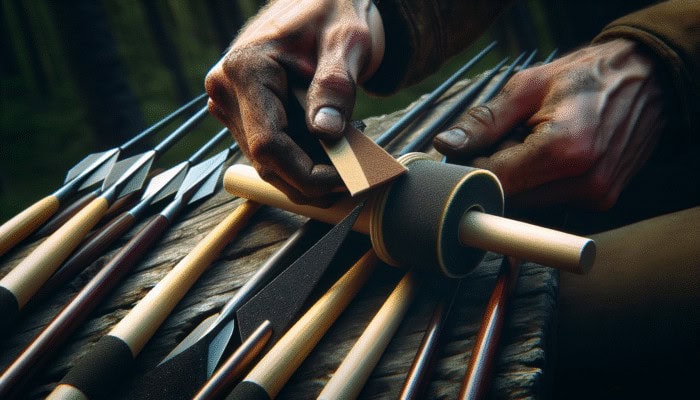Essential Guide to Selecting the Perfect Materials for Your Survival Spear
Making a Survival Spear: When embarking on the journey of crafting a survival spear, selecting the right materials is crucial. The components you choose will not only amplify the spear’s effectiveness but also significantly influence your safety and comfort during its use. In this section, we will explore how to identify the most suitable shaft materials, the best options for spear tips, adequate binding supplies, and how to assess the overall weight and balance of your spear for optimal performance.
How to Choose a Sturdy Shaft That Enhances Your Spear’s Performance

The shaft of your spear serves as its backbone, making it vital to select a straight and robust branch or pole for creating a reliable and effective weapon. Aim for a shaft that measures approximately 6 to 8 feet long, as this length provides better reach and leverage when hunting or defending against threats. Strong woods such as oak, hickory, or even bamboo are excellent choices due to their durability and manageable weight.
In dense forests or jungles, you can often find adequate shafts amidst fallen trees or branches. Always verify that the selected shaft is free from cracks and knots, as these imperfections can compromise the spear’s structural integrity, potentially leading to breakage during use. In dire survival situations, even local non-wooden materials, such as PVC piping, can serve as viable alternatives, provided they offer sufficient strength and durability.
Additionally, consider your environment when selecting materials. A spear designed for mountainous terrains will require different materials compared to one used in wetlands. Be mindful of the local flora and fauna, as they may present unique materials that can effectively complement your spear-making process, enhancing both its functionality and adaptability.
Choosing the Best Materials for Your Spear Tip: A Crucial Decision
The spear tip plays a critical role in penetration and overall effectiveness, making the choice of material for your tip extremely important. Traditionally, tips made from flint or bone have proven effective due to their ability to be sharpened to a fine point. Flint, in particular, is highly regarded for its sharpness and durability, making it a popular choice among preppers and survivalists seeking reliable tools.
In contemporary contexts, metal tips, such as those crafted from steel or iron, are favoured for their enhanced durability and lethality. These materials can be shaped into sharp points, providing excellent piercing capabilities. Often, you can repurpose discarded tools or scrap metal found in urban or rural areas to fashion effective spear tips.
Whichever material you choose for your tip, ensure that it is both sharp and resilient. The sharper the tip, the more effective it will be for tasks such as hunting and self-defense. Experimenting with various shapes, such as barbed tips, can also enhance its overall effectiveness for a range of applications.
Gathering Strong Binding Materials for a Secure Spear Construction
The choice of binding materials is crucial for ensuring that the spear tip is firmly attached to the shaft. Look for strong, flexible fibres that can withstand tension and stress during use. Sinew, derived from animal hides, offers exceptional durability and grip for securely binding the tip, while plant fibres, such as jute or hemp, can also effectively fulfil this role.
In survival scenarios, you can explore various natural materials found in your surroundings. Vines, resilient grasses, or even strips of bark can serve as effective binding agents, although they may require more frequent inspection and replacement due to their natural degradation over time.
When binding the tip, employ techniques that maximize security, such as a spiral wrap or a figure-eight knot. This approach ensures that the tip remains firmly attached during use, allowing for confident thrusts and throws. Remember, the integrity of your spear heavily relies on the quality of its bindings, so choose your materials wisely.
Assessing Weight and Balance for Enhanced Performance

A spear that is correctly balanced is essential for accuracy and ease of use. When evaluating the weight distribution, hold the spear lightly at its midpoint. It should pivot easily, indicating a harmonious balance between the shaft and the tip. If the tip feels excessively heavy, it may cause the spear to veer off course during a throw, compromising your aim.
Weight considerations also play a significant role in selecting the materials for your spear. A heavier shaft combined with a lightweight tip can lead to sluggish handling, while a lightweight shaft with a heavy tip may enhance penetration but reduce control. Strive for a balance that feels natural and comfortable in your hands, as this will directly impact your effectiveness in using the spear.
You can test the spear’s balance by performing simple throws in an open area. If the spear consistently veers off target, revisit the weight distribution by adjusting the tip’s material or repositioning the binding. Achieving the perfect balance can significantly enhance your proficiency and confidence in utilising the spear effectively.
Essential Steps for Preparing Your Spear Shaft for Optimal Performance
Proper preparation is fundamental to crafting a functional and reliable spear. This section outlines the vital steps to take for trimming, smoothing, and protecting the shaft, ensuring its optimal length and balance, thereby creating a solid foundation for your spear.
How to Trim and Straighten Your Spear Shaft for Maximum Accuracy
Begin by carefully trimming the shaft to eliminate any branches or irregularities that could hinder its performance. Using a sharp knife or saw, cut away any protruding limbs and uneven edges to ensure a smooth line from tip to base. A straight shaft not only enhances your handling but also allows for greater accuracy when thrown at targets.
In areas where the wood may be bent or warped, applying gentle heat can help straighten it. You can use a campfire or a heated stone to warm the wood, making it pliable enough to reshape. Gradually work the shaft into a straighter form, but take care not to overheat or scorch the wood’s surface, which could compromise its strength.
In survival scenarios where equipment is limited, improvisation is crucial. Use available tools or even leverage your body weight to bend the shaft into the desired shape. Keep in mind that a straight spear reduces air resistance, significantly increasing the likelihood of a successful throw and hit.
The Importance of Smoothing the Surface for Grip and Aerodynamics

A smooth surface is critical for both grip and aerodynamics, enhancing your overall experience when using the spear. Start by sanding the shaft with coarse sandpaper, gradually transitioning to finer grits to achieve a polished finish. This step reduces friction during use, making the spear more comfortable and practical to handle.
If sandpaper is unavailable, consider using natural abrasives, such as rough stones or strips of bark, to scrape down the surface. The goal is to eliminate any splinters or rough patches that could cause injury or hinder your ability to wield the spear effectively and confidently.
Pay special attention to the grip area, as adding texture or grooves can significantly enhance your control over the spear. This is particularly important in wet conditions where slippage may occur. A well-finished shaft not only boosts your confidence while using the spear but also contributes to its overall performance.
Determining the Optimal Length for Your Spear Based on Use
Determining the correct length of your spear is crucial and depends on both personal preference and the intended application. A typical survival spear ranges from 6 to 8 feet, striking a balance between reach and maneuverability without sacrificing control. When choosing the length, consider your height and how you plan to use the spear in various scenarios.
If you’re hunting larger game, a longer spear may provide the necessary reach to maintain a safe distance from your target. Conversely, if you intend to use the spear for fishing or in close-combat situations, a shorter spear can afford better control and quicker response times, making it more effective in those contexts.
To find your ideal length, hold the spear up next to your body, ensuring that it feels comfortable and easy to manage. Adjust the size as needed, but always err on the side of slightly longer, as this can be modified later through trimming to suit your preferences.
Applying a Protective Coating for Longevity and Performance
Once the shaft is properly prepared, applying a protective coating is vital for enhancing its durability and performance. Natural oils derived from plants can provide a waterproof barrier, preventing moisture from leading to rot or warping of the wood.
Alternatively, if you have access to sealants or lacquers, these can also be used, but in many survival situations, natural options are preferable. Rubbing the shaft with beeswax or animal fat can create a protective layer that not only shields the wood but also provides a smoother grip for handling.
Ensure that the coating is evenly applied, covering the entire surface area thoroughly. This step not only protects the wood but also enhances its aesthetic appeal, providing a sense of pride in your craftsmanship. Regular maintenance of the coating will keep your spear in optimal condition for years to come, ensuring it is ready for any challenges you may encounter.
Achieving Perfect Balance for Enhanced Spear Performance
After ensuring the shaft is smooth and straight, it’s time to focus on achieving balance. The goal is to have the weight distributed evenly throughout the spear, which is particularly important for effective throwing and thrusting motions.
Hold the spear at its midpoint to check its stability. It should feel nimble and responsive, not overly heavy at either end. If you find that the tip feels too heavy, consider replacing it with a lighter material or adjusting its attachment point for greater balance.
Balance is not solely about weight but also about how the spear feels in your hand. Make adjustments as necessary, and if possible, seek feedback from others who are experienced in spear use. A balanced spear will enhance your accuracy, making you a more effective user in various situations.
Expert Techniques for Crafting an Effective Spear Tip
The spear tip is the critical point of contact between you and your target, making it essential to invest time and effort into shaping it correctly. This section will focus on the processes of shaping, sharpening, and balancing the weight of your spear tip to maximise its effectiveness.
Mastering the Art of Shaping Your Spear Tip for Optimal Penetration
Creating a sharp point is where the true potential of your spear begins to take shape. Depending on the material you have chosen, use tools such as knives or chisels to carve or chip away at the tip. Your objective is to achieve a symmetrical point that allows you to penetrate your target effectively.
If you are using flint, you can employ a percussion technique to chip away at the edges, thereby creating a fine point. For bone or metal tips, gradual shaping will allow for a more controlled approach to achieving the desired sharpness. Remember, the sharper the tip, the more effective it will be when you need it most.
A well-shaped tip should possess a balanced form, ensuring it penetrates deeply without breaking on impact. As you work, consistently check for symmetry and make adjustments as needed. Testing the shape against various objects can help ascertain its effectiveness and suitability for your intended purpose.
The Importance of Sharpening the Edge for Enhanced Effectiveness
Following the shaping process, the next critical step is to sharpen the edges to a fine point. This process is vital, as the sharpness of your spear tip can significantly impact your success in hunting or self-defense scenarios.
Utilising a sharpening stone or any abrasive material, work the edges until they achieve razor-sharp precision. This attention to detail isn’t merely aesthetic; a finely honed spear tip can slice through flesh and bone with ease, thereby enhancing your chances of a successful strike.
As you sharpen, take care not to overdo it, as this can lead to an unstable tip. Regularly test the sharpness by lightly dragging it across your skin (safely and with caution) to gauge its edge. A properly sharpened tip is your spear’s frontline weapon, and it’s essential to keep it in peak condition to ensure maximum effectiveness.
Balancing the Weight of Your Spear Tip for Enhanced Performance. The weight distribution in the spear tip plays a crucial role in its flight and overall performance. A well-balanced spear ensures that it flies straight and true, making your throws more accurate and effective.
To achieve optimal balance, consider the materials used for both the tip and the shaft. If your spear is heavily tipped, it might veer off course when thrown. Adjust this by either reducing the size of the tip or altering the materials used to create it for better balance.
You can test the balance through simple throws. If the spear spirals or wobbles, it’s a sign that adjustments are needed. Aim for a design that feels good in your hand and is easy to control. A well-balanced spear is not only easier to throw but also more effective in hitting its intended target accurately.
Step-by-Step Guide to Assembling Your Spear
Crafting a spear is not solely about individual components; it involves understanding how these elements come together to create a functional weapon. In this section, we will explore the assembly process, focusing on how to securely attach the tip, reinforce connections, and perform stability tests.
How to Securely Attach the Spear Tip for Maximum Reliability
The process of attaching the spear tip to the shaft is one of the most critical steps in crafting a survival spear. Ensure the tip is securely fastened to prevent it from detaching during use. Utilise binding materials such as sinew, plant fibres, or cordage, wrapping them tightly around the junction where the tip meets the shaft to ensure a robust connection.
When binding, take care to align the tip accurately, ensuring it is straight and facing the correct direction. Employ techniques such as a figure-eight knot or a spiral wrap for added security. This approach not only ensures that the tip remains in place during use but also enhances the overall structural integrity of the spear.
Always double-check the stability of the connection before proceeding to the next steps. A loose tip can result in catastrophic failure when you need the spear most. Testing the spear’s connection by applying moderate force can help reveal any weaknesses in your assembly technique and allow for necessary adjustments.
Reinforcing the Connection for Enhanced Durability
Once the tip is securely attached, it is wise to reinforce the connection point. This can be achieved by adding extra layers of binding materials or even wrapping the junction with a tough fabric or leather strip for enhanced durability. Reinforcement helps prevent the tip from loosening or breaking off during rigorous use, which could jeopardise your safety.
Consider the environmental conditions in which you plan to use the spear. If you expect to encounter wet conditions, additional protective layers can prevent moisture from compromising the binding and weakening the connection. This step may seem minor, but it plays a significant role in ensuring the spear’s longevity and reliability.
A well-reinforced connection point can make the difference between a successful hunt and a potentially hazardous situation. Always prioritise this step, as it ensures that your spear is ready to face whatever challenges may arise during your adventures.
Testing Stability for Optimal Performance
After assembling your spear, it’s crucial to put it through its paces. Perform test throws or jabs to evaluate the spear’s balance and the stability of the tip. Please pay close attention to how it feels in your hand and how accurately it flies through the air.
A well-performing spear should feel natural and stable upon release. If it wobbles or veers off course, revisit the weight distribution and binding techniques to make necessary adjustments. Experimenting with different throwing angles and methods can provide valuable insights into the spear’s overall performance and capabilities.
Keep in mind that every spear is unique, and your testing will help you understand its strengths and weaknesses. A reliable spear will instill confidence, making you more effective in your hunting or defensive efforts, so take the time to ensure it is in top condition.
Essential Maintenance Tips for Your Survival Spear
A spear is a long-term investment in your survival toolkit, and proper maintenance is essential for ensuring its longevity and effectiveness. This section outlines the steps required to maintain your spear in optimal condition through regular inspections, sharpening, prompt repairs, and proper storage.
Conducting Regular Inspections to Ensure Functionality
To maintain your spear’s effectiveness, conduct periodic inspections for any signs of wear or damage. Pay particular attention to the tip and binding areas, as these are the most vulnerable points during use. A small crack in the shaft or a loosening tip can lead to failure at crucial moments, so vigilance is key.
Inspecting the spear after each use can help identify potential issues before they escalate into serious problems. Look for splinters, cracks, or any signs of degradation that could compromise its integrity. If you notice any damage, address it immediately to prevent further deterioration.
Additionally, consider the environmental conditions in which you store your spear. Exposure to moisture can lead to rot, while prolonged sunlight can cause warping. Maintaining a regular inspection schedule not only extends the life of your spear but also ensures your safety when using it, making it a reliable tool in challenging situations.
Sharpening and Repairing Your Spear for Optimal Performance
Keeping the spear tip sharp is essential for maintaining its effectiveness in the field. Regularly sharpen the edges using your preferred method, whether it’s a sharpening stone or a natural abrasive. A sharp tip is critical for both hunting and self-defense, significantly enhancing your chances of success when it matters most.
In cases of damage, be prepared to repair your spear promptly. Whether it involves re-binding the tip or replacing a damaged shaft, timely repairs can prevent the need for a complete rebuild. Always carry basic repair materials in your survival kit to address issues on the go, ensuring your spear remains operational at all times.
Additionally, consider using protective coatings to guard against rust or decay. Applying natural oils or wax can create a barrier that prevents moisture from degrading your spear, ensuring it remains ready for action whenever needed.
Best Practices for Proper Storage of Your Spear
How you store your spear can significantly affect its longevity and performance. Always keep it in a dry, safe place, away from direct sunlight and moisture sources. Ideally, store the spear upright or horizontally in a location that prevents it from being bent or damaged during storage.
If you’re in a wet environment, consider using a protective bag or wrapping it in a waterproof material to prevent rot. For those in colder climates, ensure that the spear is not exposed to freezing temperatures, as this can cause wood to become brittle and less effective.
Implementing proper storage practices can significantly extend the life of your spear, allowing you to rely on it for years to come. A well-maintained spear will always be ready for any challenges you may face in the wild or during survival situations.
Mastering the Use of Your Survival Spear
Understanding how to use your spear effectively is just as important as crafting it. This section covers essential hunting techniques, defensive strategies, and versatile applications that can transform your spear into an indispensable tool within your survival arsenal.
Strategic Hunting Techniques to Maximise Success
When hunting with a spear, strategy is paramount. Stealth is your best ally; approach your target quietly to avoid detection. Keep your movements slow and deliberate, using natural cover to conceal your approach. Understanding the behaviour of your prey can significantly enhance your chances of making a successful strike, so invest time in studying their patterns.
Targeting vital areas—such as the neck or heart—can ensure a quick and ethical kill. Aim for accuracy, ensuring that your spear flies straight and true. Practising your throws in a safe environment allows you to develop muscle memory and improve your precision, ultimately leading to a more successful hunting experience.
Additionally, consider the type of prey you’re targeting. Smaller game may require different techniques than larger animals. For instance, a quick thrust may suffice for small creatures, while larger game may necessitate a more powerful throw to ensure a clean strike. Adapting your approach based on the situation can significantly enhance your overall success rate in hunting scenarios.
Defensive Strategies for Effective Protection
In a survival scenario, your spear can serve as an effective defensive tool. Understanding proper gripping techniques is crucial, as it allows for quick thrusting and blocking motions when faced with a threat. Hold the spear firmly, keeping your hands in the correct position for maximum control and stability.
Maintaining distance from an opponent is vital. Use the spear’s length to your advantage, keeping your adversary at bay. Thrusting motions can create both space and defense, allowing you to fend off attackers while preparing for your next move. Training your body to react quickly in high-stress situations will also enhance your effectiveness in self-defense scenarios.
Regular practice will enhance your reaction times and precision, enabling you to defend yourself confidently when necessary. Remember, a well-prepared individual is often able to navigate dangerous situations with greater ease and success.
Versatile Applications for Your Spear Beyond Hunting and Defense
Beyond hunting and self-defense, your spear can serve multiple functions in a survival context. In natural settings, it can be effectively used for fishing, simply thrusting it into shallow waters or targeting fish that jump near the surface. The sharp tip allows for quick strikes, making it an efficient fishing tool that can supplement your food sources.
Additionally, the spear can be used for digging. Use the tip to break the ground when searching for roots or tubers, which can serve as vital food sources in survival scenarios. This versatility makes your spear an invaluable tool, suitable for a wide range of tasks in the wild, enhancing your overall chances of survival.
Embracing creativity in using your spear can significantly expand its applications. Whether it’s for crafting, fishing, or self-defense, this multifaceted tool enhances your ability to survive and adapt in diverse environments, showcasing the importance of resourcefulness in challenging situations.
Commitment to Maintenance and Care for Longevity
The effectiveness of your spear hinges on your commitment to its maintenance. Regularly cleaning the tip, inspecting the binding, and checking for any signs of wear are essential practices to ensure that your spear remains in peak condition. After each use, wipe the spear down to remove any residue or moisture that could lead to decay or deterioration over time.
Sharpening the tip should be a routine part of your maintenance, ensuring it remains deadly and effective when needed. Store the spear in a protective garment when not in use, and regularly check for any environmental effects that could compromise its integrity, such as moisture or extreme temperatures.
Remember, your spear is an extension of your skills and preparation. A well-maintained spear not only improves your chances of success in the wild but also serves as a testament to your commitment to survival and self-sufficiency in challenging environments.
Frequently Asked Questions About Crafting and Using Survival Spears
What materials are ideal for constructing a survival spear?
The best materials for constructing a survival spear include a sturdy wooden shaft, sharp tips made from flint, metal, or bone, and strong fibres, such as sinew or plant materials, for effective binding.
What is the recommended length for a survival spear?
A survival spear typically ranges in length from 6 to 8 feet, striking a balance between reach and maneuverability that is tailored to personal height and the intended use of the spear.
Can I use plastic materials for the spear shaft?
Yes, plastic, particularly sturdy PVC, can be utilised as a spear shaft in survival scenarios, provided it offers adequate strength and does not bend easily under pressure.
How can I test the balance of my spear?
To test the balance of your spear, hold it at its midpoint and check if it pivots easily. A well-balanced spear will feel stable and responsive in your hand, allowing for accurate throws.
What is the best technique for sharpening a spear tip?
The best method for sharpening a spear tip is to use a sharpening stone or abrasive material. Regular honing will keep the edge sharp and effective for hunting or self-defense applications.
How often should I inspect my spear for damage?
You should inspect your spear after each use, paying close attention to signs of wear or damage, particularly at the tip and binding areas, to ensure its continued effectiveness and reliability.
Can I use my spear for fishing purposes?
Absolutely! A survival spear can be effectively used for fishing, allowing you to thrust into shallow waters or target fish that are jumping near the surface, making it a versatile tool for food procurement.
What type of protective coating should I apply to my spear?
Natural oils, such as those derived from plants, can provide a waterproof barrier for your spear, while beeswax or animal fat can also be used for sealing and protecting the wood from moisture-related damage.
What are the best practices for storing my survival spear?
Store your survival spear in a dry, safe location, away from direct sunlight and moisture sources. Keeping it upright or horizontally can prevent warping or damage over time, ensuring it remains ready for use.
Is it possible to make a spear in an urban environment?
Yes, urban environments can provide various materials for crafting a spear, such as discarded metal or wooden items. Creativity in sourcing materials is essential in these settings, allowing you to adapt to your surroundings.
Follow our journey on X for more survival tips!
Survival Compass Guide: Essential Tips for Navigation
Mastering Compass Navigation: Essential Knowledge and Techniques What is a Compass and Its Importance? Survival Compass Guide: A compass is an indispensable navigational tool that enables individuals to ascertain direction in relation to the Earth’s magnetic poles. This device typically features a magnetised needle that consistently points towards magnetic north, facilitating orientation in unfamiliar terrains. […]
SHTF Hunting Skills: Essential Techniques for Survival
Mastering the Essentials of SHTF Hunting Gaining Insight into Prey Behaviour for Success SHTF Hunting Skills: Understanding the habits and patterns of various animals is fundamental to increasing your chances of a successful hunt. This knowledge is not merely beneficial but essential for survival in any environment, particularly during an SHTF scenario where food sources […]
Wilderness Weather Prediction: Essential Techniques
Comprehending the Dynamics of Wilderness Weather Patterns Key Factors That Influence Weather Variability in Wilderness Areas Wilderness Weather Prediction: The weather in wilderness regions is a multifaceted interaction among numerous elements that can fluctuate dramatically depending on the surrounding environment. One of the most significant factors is altitude; as one ascends, temperatures generally decrease, which […]
Shtf Fire-Starting: Essential Techniques and Tools
Mastering the Fundamental Concepts of SHTF Fire-Starting Comprehending the Essential Fire Triangle Shtf Fire-Starting: The fire triangle is a fundamental concept that anyone serious about SHTF fire-starting must understand. This triangle comprises three vital elements: heat, fuel, and oxygen. Mastering these components is essential for successful fire-starting in any scenario. Without heat, you cannot ignite […]








This guide on selecting the right materials for a survival spear really resonates with me. The careful consideration of the shaft’s strength and length speaks to the importance of craftsmanship, especially in outdoor survival scenarios where every detail can impact one’s safety and success.
It’s great to hear that the guide resonated with you. You’re spot on about the shaft’s strength and length—those details can make a world of difference when you’re relying on your gear. Craftsmanship really does play a significant role, and I think it’s fascinating how much we can learn from traditional techniques.
You’ve hit on something crucial about the materials and craftsmanship involved in crafting a survival spear. It’s not just about having a pointy end; the right shaft can mean the difference between a sturdy, reliable tool and one that fails when you need it most.
“I’m glad to hear that! If you’re looking to further enhance your survival skills, check out this resource for quality materials and tips that can elevate your craftsmanship.”
https://survivalbite.com/wild
Your exploration of selecting the right materials for a survival spear strikes at the very heart of practical wilderness skills! I find it fascinating how the choice of a spear shaft can remarkably influence not just the spear’s effectiveness but also the user’s experience. Personally, I’ve always held a deep appreciation for the beauty and utility of natural materials. When crafting my own spears, I’ve had some success using local wood types, like cedar and ash, which not only provide decent strength but are also relatively lightweight.
It’s interesting that you emphasize the shaft’s material as the backbone of the survival spear. I’ve found that many people overlook the importance of flexibility in addition to strength. While a sturdy wood like hickory is great, a bit of bend can actually help absorb impact, which is crucial when you’re in a survival scenario.